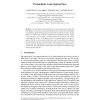ECCV
2004
Springer
15 years 5 months ago
2004
Springer
This paper deals with the computation of optical flow and occlusion detection in the case of large displacements. We propose a Bayesian approach to the optical flow problem and s...
89
Voted
DAGM
2005
Springer
15 years 5 months ago
2005
Springer
Usually, optical flow computation is based on grayscale images and the brightness conservation assumption. Recently, some authors have investigated in transferring gradient-based ...
132
click to vote
WACV
2005
IEEE
15 years 5 months ago
2005
IEEE
Scene flow methods estimate the three-dimensional motion field for points in the world, using multi-camera video data. Such methods combine multi-view reconstruction with motion...
108
click to vote
ICIP
2005
IEEE
15 years 5 months ago
2005
IEEE
In this paper, we propose a novel technique to represent and recover optical flow through free form deformations. Such a technique is based on representing the motion field usin...
ICCV
2005
IEEE
15 years 5 months ago
2005
IEEE
We develop a method for learning the spatial statistics of optical flow fields from a novel training database. Training flow fields are constructed using range images of natur...
CVPR
2010
IEEE
15 years 5 months ago
2010
IEEE
The accuracy of optical flow estimation algorithms has been improving steadily as evidenced by results on the Middlebury optical flow benchmark. The typical formulation, however...
114
click to vote
ICIAR
2007
Springer
15 years 5 months ago
2007
Springer
Abstract. We describe the implementation of a 2D optical flow algorithm published in the European Conference on Computer Vision (ECCV 2004) by Brox et al. [1] (best paper award) a...
ICRA
2007
IEEE
15 years 6 months ago
2007
IEEE
— We present a strategy for generating real-time relative depth maps of an environment from optical flow, under general motion. We achieve this using an insect-inspired hemisphe...
103
Voted
CRV
2007
IEEE
15 years 6 months ago
2007
IEEE
When an observer moves in a 3D static scene, the motion field depends on the depth of the visible objects and on the observer’s instantaneous translation and rotation. By compu...
77
Voted
ICPR
2008
IEEE
15 years 6 months ago
2008
IEEE
This paper suggests using discrete feature displacements and optical flow simultaneously to determine the camera motion and its velocity. This is advantageous when the number of ...





